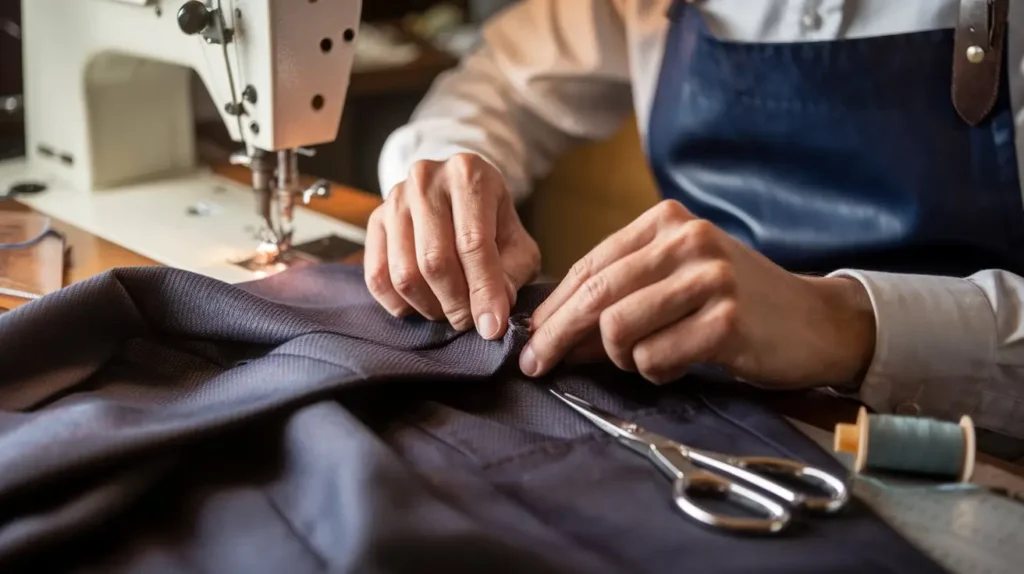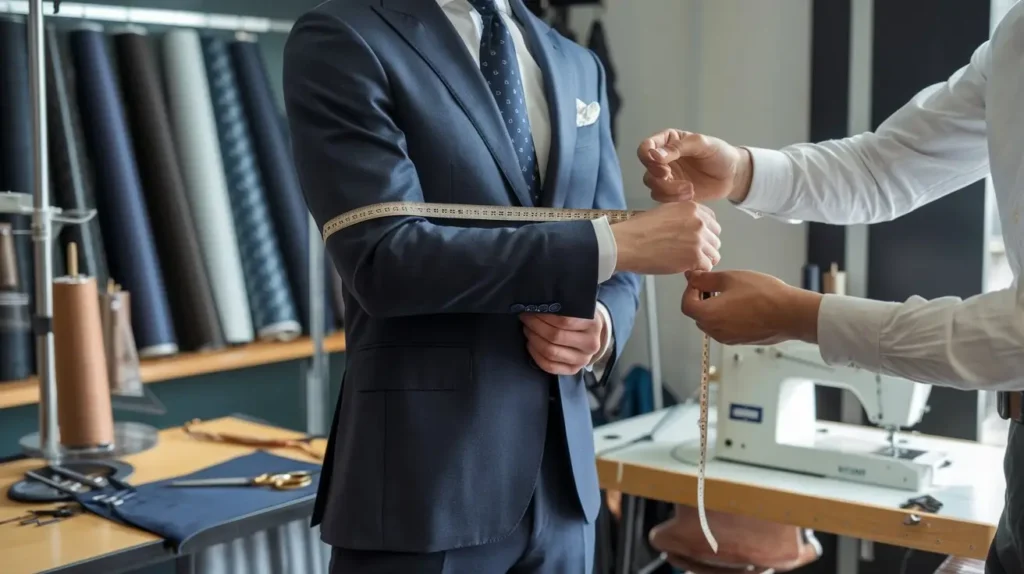Men’s Guide to Tailoring 101: When and How to Alter Clothes
Finding the right fit for your clothes can make all the difference in how you look and feel. Off-the-rack clothing rarely fits perfectly, but that doesn’t mean you’re stuck with it. This is where tailoring comes in. Whether it’s a suit that’s a bit too loose or a pair of pants that need hemming, professional alterations can give your wardrobe a custom feel without the hefty price tag of bespoke clothing.
But when is it worth altering a garment, and when should you just leave it as is or replace it? And what exactly can a tailor fix? In this guide, we’ll break down the basics of tailoring, including how to decide when to get your clothes professionally altered and what you can expect from common adjustments. So, without further ado, let’s get started!
Contents
When to Consider Professional Alterations
Not every piece of clothing needs a trip to the tailor. But in some cases, a few nips and tucks can make a world of difference. Here’s when you should think about getting your clothes professionally altered:
1. The Basics Don’t Fit Quite Right
We’ve all got those staple pieces that should be perfect but aren’t. Maybe it’s:
- Pants that pool around your ankles
- Shirt sleeves that cover your hands
- Jackets that make you look like you’re playing dress-up in your dad’s closet
These are prime candidates for tailoring. A good tailor can adjust these pieces to fit you like a glove, making them look like they were made just for you.
2. Special Occasions Are Coming Up
Got a wedding, job interview, or big presentation on the horizon? These are times when you want to look your absolute best. Even if you’ve bought a new outfit for the occasion, a few alterations can take it from off-the-rack to red-carpet ready.
3. You’ve Invested in Quality Pieces
If you’ve splurged on a high-quality item, like a designer suit or a classic wool coat, it’s worth spending a bit more to make sure it fits perfectly. These pieces are meant to last for years, so getting them tailored is a smart long-term investment.
4. Your Body Has Changed
Life happens. Maybe you’ve lost weight, gained muscle, or your body’s changed in other ways. Instead of buying a whole new wardrobe, consider getting your favorite pieces altered to fit your new shape.
5. You Love It, But…
We all have that one item we adore but never wear because the fit is just a bit off. Don’t let it languish in the back of your closet! A good tailor can often work magic and turn it into something you’ll reach for again and again.
Types of Alterations
Now that you know when to consider tailoring, let’s talk about what kinds of alterations are possible. Tailors can do a lot more than just hem pants!

Hemming: This is probably the most common alteration. It’s not just for pants – trousers, and even sleeves can be hemmed.
Waist Adjustments: Tailors can take in or let out waistbands on pants and suits.
Tapering: This involves narrowing the width of garments, like slimming down baggy pants or giving a boxy shirt a more fitted silhouette.
Shoulder Alterations: A skilled tailor can adjust the shoulder width of jackets and shirts.
Sleeve Length: Too long or too short? Sleeves on shirts, jackets, and coats can be lengthened or shortened.
Zipper Replacement: Don’t toss that jacket with the broken zipper! A tailor can replace it.
Pro Tip: For those who frequently need pants hemmed, consider investing in a quality sewing machine like the Brother CS6000i. It’s user-friendly and perfect for simple alterations.
How to Find a Good Tailor
Finding a great tailor is like finding a great hairstylist – once you do, you’ll wonder how you ever lived without them. Here’s how to find your perfect match:
1. Ask Around
Start by asking friends, family, or colleagues for recommendations. Personal experiences can be incredibly valuable.
2. Check Online Reviews
Sites like Yelp or Google Reviews can give you a sense of a tailor’s reputation. Look for consistently positive feedback.
3. Visit Local Shops
Many dry cleaners offer alteration services. Pop in and ask about their experience with different types of garments.
4. Test the Waters
Before entrusting your favorite pieces, try a tailor out with a simpler job, like hemming a pair of pants.
5. Look for Specializations
Some tailors specialize in certain types of clothing, like suits or wedding attire. If you have a specific need, look for someone with relevant expertise.
What to Look for in a Skilled Tailor
- Attention to Detail: A good tailor will take precise measurements and pay attention to small details.
- Clear Communication: They should be able to explain what they’re doing and why.
- Reasonable Turnaround Time: While quality work takes time, be wary of excessively long waits.
- Fair Pricing: Prices should be transparent and in line with the complexity of the work.
Remember, a skilled tailor is an investment in your wardrobe. Don’t be afraid to shop around until you find someone you trust.
Preparing for Your Tailor Appointment
So, you’ve found a tailor and you’re ready to transform your wardrobe. Here’s how to make the most of your appointment:

Wear the Right Stuff
- For pants: Wear the shoes you’ll typically pair with the garment. This ensures the right hem length.
- For jackets or shirts: Wear the type of shirt or top you’ll usually wear underneath.
Be Clear About What You Want
Don’t be shy – communicate clearly about what you’re looking for. If you’re not sure, ask for the tailor’s professional opinion.
Trust the Process
A good tailor might pin and mark your clothes in ways that look strange at first. Trust their expertise, but don’t be afraid to speak up if something doesn’t feel right.
Be Realistic
Some alterations might not be possible or could change the look of the garment significantly. A good tailor will let you know if your request isn’t feasible.
Pro Tip: If you’re getting multiple items altered, prioritize them. Start with the pieces you wear most often or need as soon as possible.
Cost Expectations
The cost of alterations can vary widely depending on where you live, the complexity of the work, and the tailor’s expertise. Here’s a rough guide to what you might expect to pay:
- Hemming pants: $20-$30
- Taking in a shirt: $15-$30
- Shortening sleeves on a jacket: $20-$40
- Adjusting the waist on pants: $20-$40
- Tapering pants: $20-$40
Remember, these are just estimates. Prices can be higher for complex work or delicate fabrics. Always ask for a quote before committing to any alterations.
When Alterations Might Not Be Worth It
While tailoring can work wonders, sometimes it’s better to pass:
- If the alteration would cost more than half the price of the garment
- If the fabric is already worn out or damaged
- If the alteration would change the overall design of the piece significantly
In these cases, it might be better to donate the item and invest in something new.
DIY vs. Professional Tailoring
While there’s no substitute for professional tailoring, there are some simple fixes you can do at home:
DIY-Friendly Alterations:
- Hemming pants with hem tape
- Sewing on buttons
- Taking in a waist with elastic
- Using fashion tape for temporary fixes
For these simple jobs, a basic sewing kit can be a lifesaver. We recommend the Singer Sewing Kit for beginners.
Leave to the Pros
- Anything involving structured garments like suits or lined jackets
- Significant size adjustments
- Work on delicate or expensive fabrics
- Complex alterations like changing a neckline or resizing shoulders
Remember, if you’re unsure, it’s always better to consult a professional. A botched DIY job can ruin a garment beyond repair.
FAQ
Q: How long does tailoring usually take?
A: It depends on the complexity of the alteration and the tailor’s workload. Simple jobs like hemming pants might take a few days, while more complex alterations could take a week or more.
Q: Can all clothes be altered?
A: Most clothes can be altered, but some fabrics and designs are more challenging than others. It’s always best to ask a professional tailor about specific items.
Q: Is it worth tailoring cheap clothes?
A: It depends. If it’s a piece you love and wear often, even if it’s inexpensive, tailoring can be worth it. However, for very cheap items, the cost of tailoring might outweigh the value of the garment.
Q: Can tailors make clothes bigger?
A: In some cases, yes. It depends on the garment and how much extra fabric is available in the seams. It’s often easier to make clothes smaller than larger.
Q: How do I know if my tailor did a good job?
A: The alterations should be invisible – you shouldn’t be able to tell the garment was altered. The item should fit comfortably and look natural on your body.
Remember, the key to a great wardrobe isn’t just buying the right clothes – it’s making sure they fit you perfectly.